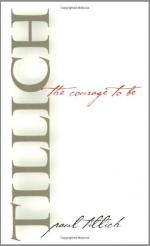|
This section contains 817 words (approx. 3 pages at 400 words per page) |

|
Summary
In this chapter, the shortest of the book, Tillich turns initially to pathological anxiety, which he defines as a type of non-existential anxiety that comes about due to the vagrancies of life’s occurrences, i.e., events and experiences that cannot be predicted or accounted for ahead of time. While Tillich appreciates recent psychological and psychoanalytic discourse aimed at ameliorating this type of anxiety—specifically those outlined by Sigmund Freud—he believes that anxiety cannot be adequately addressed without first engaging in rigorous ontological analysis. Ontology, once again, is always already prior, not only in terms of human life, but also organic life writ large. Pathological anxiety is taken to be a type of neurosis, a “way of avoiding nonbeing by avoiding being” (66). The result is a type of diminished self-affirmation in which an individual fails or refuses to...
(read more from the Chapter 3: Pathological Anxiety, Vitality, and Courage Summary)
|
This section contains 817 words (approx. 3 pages at 400 words per page) |

|




